Walk – Hulne Park, Alnwick
A walk by many of the historic buildings, monuments and other features of Alnwick town.
Time: 3½ hours
Difficulty: – (2)
(1: easy 4: difficult)
This walk is generally on the flat but there are some hills to walk up for Bridle Tower and from the iron bridge to Park Farm.
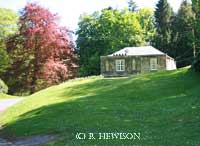
Start: Alnwick Market Place.
From the Market place walk down Paikes street and turn left at the bottom onto Narrowgate. Walk down Narrowgate for about two hundred yards then just venture momentarily into Pottergate (on your left) look to your left and you will see the bronze statue of Sir Henry Percy also known as ‘Harry Hotspur’
Hotspur was the eldest son of Henry Percy 1 st Earl of Northumberland and 4 th Lord Percy of Alnwick.
His nickname Hotspur is thought to refer to his impulsive nature.
Hotspur was killed whilst leading a rebellion against Henry IV in 1403, he was said to have lifted his visor to get some air and was shot in the mouth with an arrow killing him instantly.
In Shakespeare’s “Henry the IV part 1” The Earl of Northumberland was Henry and Hotspur is the nickname of his son Henry.
Back onto Narrowgate and walk up towards the Barbican entrance to Alnwick Castle. This was once the main entrance to Alnwick Castle and was a ‘murder alley’ if you were the ‘wrong sort’
At the top of Narrowgate turn left onto Bailiffgate – a lovely wide tree lined street. Continue along Bailiffgate. You will come to the Church of St. Michael.
The church has its origins in Saxon times and was extended and underwent major rebuilding during the 14 th and 15 th centuries. It is one of Northumberland’s architectural gems.
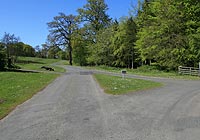 At the church you will see that he road begins to bend downhill. Don’t follow the road but take the minor road straight ahead of you with the stone wall on your left side, this is called “Ratten Row”. About 1/3 of a mile further on you will come to the arched entrance way to Hulne Park.
At the church you will see that he road begins to bend downhill. Don’t follow the road but take the minor road straight ahead of you with the stone wall on your left side, this is called “Ratten Row”. About 1/3 of a mile further on you will come to the arched entrance way to Hulne Park.
Walk through the arch; follow the tarmac drive without turning off, you will pass ancient walled enclosed fields on your right with fantastic views to left and right.
After a mile or so you will see that the entrance to Park Farm is on your right. Continue past this junction and about 400 yards further on you will see a gravel track on your left. Take a detour here and follow the track up hill. Go straight on, about ½ mile further on you will come to Brizlee Tower on your right; it is an incredible piece of stone masonry. 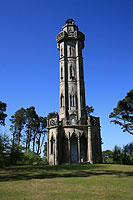
The tower (a folly) is gothic in style and resembles a multi-tiered wedding cake with a beacon on top. The tower is a grade 1 listed building. It was designed by Robert Adam in 1777 and erected in 1781 for Hugh Percy 1 st Duke of Northumberland.
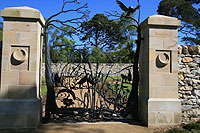 Come back to the track and with the tower behind you turn right along the track you were on a few moments ago. The track goes downhill slightly and then bears left. About half a mile from the Brizlee Tower you will come to a walled enclosure, the new cemetery for the Percy Family. Here you will find a pair of magnificent iron gates.
Come back to the track and with the tower behind you turn right along the track you were on a few moments ago. The track goes downhill slightly and then bears left. About half a mile from the Brizlee Tower you will come to a walled enclosure, the new cemetery for the Percy Family. Here you will find a pair of magnificent iron gates.
The gates are wrought in Iron by the famous Northumberland blacksmith, Stephen Lunn. The gates feature wildlife from Hulne Park, landscape, river, and trees. They have to be seen to be believed.
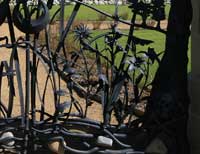 Continue along the track passing the enclosure on your left. You will come to a crossroads where you turn left. About half a mile from the enclosure you will find the statue of a monk, possibly from Hulne Priory, standing sentinel beside a cave where a hermit was said to have lived.
Continue along the track passing the enclosure on your left. You will come to a crossroads where you turn left. About half a mile from the enclosure you will find the statue of a monk, possibly from Hulne Priory, standing sentinel beside a cave where a hermit was said to have lived.
Pass the monk and the cave, continue along the track and you will come to a T junction. This is the track you first walked up from the road. Turn right and walk downhill to the tarmac road at the bottom. At the road turn left.
About a mile further on you will come to East Brizlee Farm, follow the road past the farm, and going downhill after the farm you will come to the bridge over the river Aln. Cross the bridge and turn right. After a hundred yards or so you are requested to leave the gravel road and walk along the river bank (which will be on your right.) After about a mile you will emerge back onto the gravel road, turn right. On the hill to your left you will see Hulne Priory. You can visit this if you wish.
Hulne Priory was founded in 1240 by Carmelite monks, making it possibly the first Carmelite priory in England. During the Dissolution of the Monasteries by Henry the VIII the main part of the priory was destroyed, however many parts of the monastic buildings remain intact within the enclosure. There are later sculptures of monks in prayer scattered around the grounds. After dissolution the property was taken over by the Percy’s – Dukes of Northumberland.
Along the track before reaching the priory you will see an ornate iron blue painted bridge over the river Aln. Cross the bridge and follow the obvious track in front of you, several hundred yards further on you will come to a gate, go through the gate and follow the track uphill. At the end of the track you will come to another gate at a tarmac road. This is near the Park Farm. Go through the gate and turn right. At the next T junction turn left (you will have emerged onto the tarmac road you were on earlier at the Park Farm junction) retrace your steps back to the entrance to Hulne Park.
As you exit through the archway of Hulne Park look to your right and you will see a memorial stone through railings, this refers to the Scottish King Malcolm.
On the 13 th of November 1093 after ‘The Battle of Alnwick’ and his successful attack on Alnwick Castle, Malcolm was accepting the surrender of Alnwick Castle by being offered the keys to the castle at the end of a lance. Bending to pick the keys from the lance, the lancer thrust the lance into Malcolm’s eye whereupon he died in agony. His eldest son, Edward was also killed in the same battle. (Malcolm was the son of Duncan who was killed by Macbeth.)
(See – www.englishmonarchs.co.uk/dunkeld_2.htm)
Walk back to Alnwick Castle.
The town of Alnwick existed before William the Conqueror, but most recorded history exists after the Norman Barons took up their positions around the country and the first castle was built. The first castle builder was Gilbert De Tesson, followed by the De Vesci family and passed into the Percy family in 1309.
If you would like a good photo opportunity, turn left at the Castle and walk down the Peth, over the Lion Bridge – a most picturesque stone bridge. Walk up the hill until you come to the viewpoint on your right. From here you will get a perfect unobstructed timeless view of Alnwick Castle. Walk back to Market Place to finish.
Comments:
- The walk within Hulne Park is partly on a tarmac road with very light traffic. The speed limit on this road is a maximum of 30mph but most traffic passes you at a much slower speed.
- Good walking shoes are recommended but boots are not required.
- There are no refreshment facilities within the park so a drink and a packed snack is a good idea.
- Please take any litter home with you.
- Although the park open most of the time it is owned by Northumberland Estates (Duke of Northumberland) and may be closed at certain times near the end of summer. If you wish to confirm opening you will need to contact Northumberland Estates on 01665 510777.
Alnwick Walks and Rothbury & Coquetdale Walks
are the copyright of
B. Hewison @ www.westacrehouse.co.uk, Alnwick. Tel. 01665 510374
Disclaimer: Some of these walks are on the Public Highway, although the route chosen is usually very quiet, please remember that vehicles may legally travel along open country roads at speeds in excess of 30 mph. If possible, please walk along the right side of the highway or the verge if appropriate. Please stay on the right hand side, facing the traffic. This walk has been provided in good faith and the author can accept no liability for any accidents which may occur.
Walking Northumberland Links:
www.walking-routes.co.uk
Shepherds Walks
www.footstepsnorthumberland.co.uk
Enjoy photos of the area by Graeme Peacock
If you have a favourite walk in Northumberland, particularly in Alnwick District and you would like to share it with others send us an email to West Acre House and we could include it on these pages with a credit to you.
Reproduction of the information contained herein is usually permitted with permission of the owner.